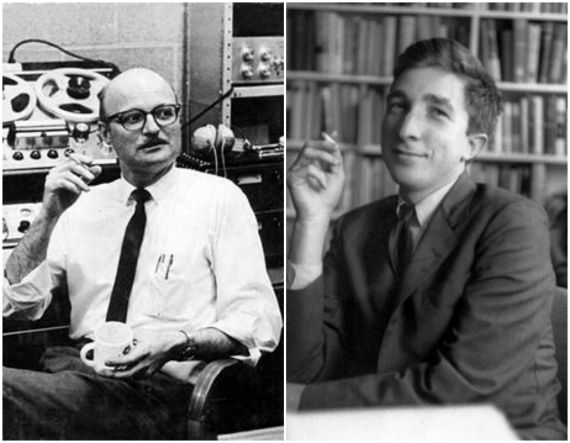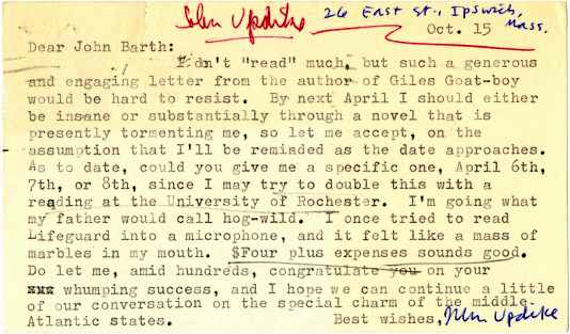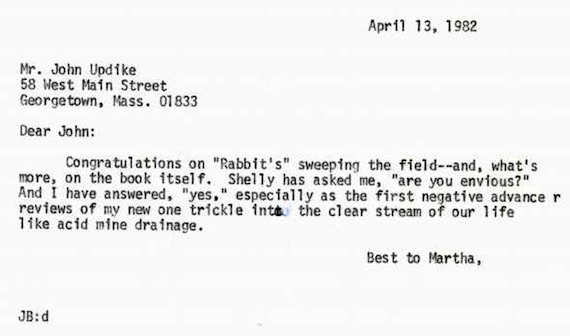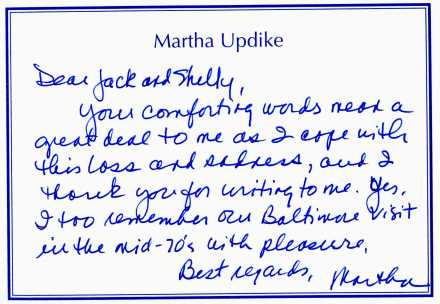

 It was October of 1966 and John Barth had just published Giles-Goat Boy, a 700-page postmodern comedy, and a New York Times Bestseller. Barth was starting the stories that would eventually make up Lost In The Funhouse, a seminal work of metafiction. He was teaching at the University of Buffalo and was busy putting together a week-long reading series for the following spring. He had already secured writers like Norman Mailer, Joseph Heller, Isaac Bashevis Singer, and John Hawkes – author of the spectacular surrealist Western, The Beetle Leg. The series would feature some of the most powerful literary figures of the time. But Barth was working to finish the line-up with one more writer, a man he admired and sought to befriend; he wanted to get John Updike.
It was October of 1966 and John Barth had just published Giles-Goat Boy, a 700-page postmodern comedy, and a New York Times Bestseller. Barth was starting the stories that would eventually make up Lost In The Funhouse, a seminal work of metafiction. He was teaching at the University of Buffalo and was busy putting together a week-long reading series for the following spring. He had already secured writers like Norman Mailer, Joseph Heller, Isaac Bashevis Singer, and John Hawkes – author of the spectacular surrealist Western, The Beetle Leg. The series would feature some of the most powerful literary figures of the time. But Barth was working to finish the line-up with one more writer, a man he admired and sought to befriend; he wanted to get John Updike.
“I’ve been told you don’t make public appearances, and I sympathize,” Barth wrote to Updike. Updike had won the National Book Award for The Centaur three years prior, and Rabbit, Run was only half a decade old. Updike was 34. Barth was 36. Barth wrote to Updike, “…as one who respects your work, and suspects it would sound excellent to the ear in the author’s voice, and has agreed to read something of my own to help out, and wants to meet you better anyhow than I did at the Academy last Spring, I’d be honored, and we all delighted, if you’d bend your admirable policy once and lay some of your prose on us out loud.”
Barth was genial with many alpha literary fiction writers throughout his career – eventually even men like Philip Roth, Italo Calvino, and Salman Rushdie. But Barth was an alpha writer himself, in the mid-60’s, a literary artist and intellectual who was both wildly innovative and popular. Barth largely associated with other experimentalists – people like William Gaddis, Donald Barthelme, and William Gass – but then he was especially drawn to Updike. Updike was a realist, and this genre discrepancy served as a sort of important buffer to literary bitterness and jealousy, especially as time went on.
Other writers knew about Updike’s aversion to public speaking. Updike had only ever taught one course, in the early 1960s, at the Harvard Summer School and disliked the experience so intensely that he vowed to never do it again. Updike covered a single additional class session in the Fall of 1966 at Boston University – after John Cheever called him, too drunk to stand up – and that was his final appearance in the classroom.

Barth wrote to Updike anyway. Updike responded, “I don’t ‘read’ much, but such a generous and engaging letter from the author of Giles Goat-boy would be hard to resist. By next April I should either be insane or substantially through a novel that is presently tormenting me, so let me accept, on the assumption that I’ll be reminded as the date approaches.”
Updike went to Buffalo in 1967. Barth stood at the front of a crowded auditorium and enumerated the ways that Updike’s writing was distinctive in a time of high postmodernism and experimentation. “His materials and methods remain essentially realistic, straightforwardly if subtly representational, as opposed to the diverse anti- and irrealisms of most of his contemporaries.” Barth said, “He’s non-apocalyptic, a highly unfashionable attitude – one suspects he may not even be a nihilist.”
Barth certainly thought of himself as one of those irrealist writers he mentioned in Updike’s introduction. He had begun writing Lost In The Funhouse: Fiction for Print, Tape, Live Voice. The book begins with a note from the author, in which Barth writes that many of these stories aren’t actually meant for the page. Barth says “Glossolia,” for example, “will make no sense unless heard in live or recorded voices, male and female.” Despite finally limiting some of those ambitions to the printed word, a story like, “Night-Sea Journey” – a sperm’s existential reflections on its swim to fertilize an egg – is brilliant. Stories like “Lost In The Funhouse”, “Autobiography”, and “Title” are, too. Some of the others – “Echo”, “Menelaiad”, “Anonymiad” – really stumble.
 Six years after the Buffalo reading, and around the time Barth published his National Book Award-Winning trio of novellas, Chimera, Barth moved back to Baltimore to teach in the writing program at Johns Hopkins, his alma mater. He was put in charge of another speaker series. He again sought John Updike.
Six years after the Buffalo reading, and around the time Barth published his National Book Award-Winning trio of novellas, Chimera, Barth moved back to Baltimore to teach in the writing program at Johns Hopkins, his alma mater. He was put in charge of another speaker series. He again sought John Updike.
In October 1974, Updike wrote back and accepted that invitation. Updike then shared some unhappy news: “You and [Barth’s wife] Shelley will be sorry to hear that Mary and I seem to be undergoing that American, or is it menopausal, experience called separation. Hence the urban address below. I work, eat, sleep, and read all on the same head of a pin-sized apartment, and seem happy in a way, or at least less asthmatic.”
Barth conveyed his distress and sent his best wishes to Updike and his wife. He hoped Updike was able to write in his “diminished physical plant.”
Updike furthered the intimate tone of the exchange with his response. He wrote, “A curious bit of etiquette – having no wife to bring, might I bring someone else?… The substitute would be, I would think, a mature American female, quiet and mannerly, not apt to embarrass any proceedings. I haven’t invited any yet, just wondering, way in advance.”
Barth wrote to Updike that he would set him up in the Nichols House, which would be comfortable “with or without mature American female, whom by all means, bring.”
On Friday, April 18th, 1975, Updike arrived in Baltimore with, in his words to Barth, “A Martha Bernhard (37, une autre séparée, onetime student of Nabokov at Cornell).” Leslie Fiedler, the book critic, had a campus event that same day. The group of them went to Updike’s afternoon reading, then Fiedler’s evening lecture, then out to dinner.
The next morning, Barth and Shelley and Updike and Martha went on a literary tour of Baltimore. They visited Edgar Allan Poe’s grave. They went to the H.L. Mencken House. They got soft-shell crab for lunch. Then John and Martha got on a plane back to Massachusetts.
Gracious letters from both Bernhard and Updike followed. Bernhard wrote, “Dear Shelley and Jack, You were dear to let me tag along to watch John enchant your students, a pleasant occasion for me of course. Beyond that, I was moved by your graciousness and acceptance in what could have been an awkward situation. But it was charming, really, because of your gentleness. Lovely of you.” She added that the Barths were fortunate to have seen Updike in a “role he shies from but does beautifully.”
Updike, for his part, said, “Martha was greatly touched and cheered by the lack of awkwardness in an adventure, a venturing forth, that was a touch barefaced for us. You were both most kind.” Then he goes on to ask Barth if he can get him a Johns Hopkins University sweatshirt for a souvenir, “with as it happens [his] initials on it.”
Updike and Martha got married in 1977. They were married for 31 years, the rest of Updike’s life.
After Updike died, Martha told Barth in a letter that this first trip was not only the beginning of her relationship with Updike, but also the occasion on which Updike changed his mind about readings. “He took to it,” Martha wrote, “as he didn’t to teaching, and thus began a modest, but consistent, reading schedule that he truly enjoyed.”
Following the Baltimore visit, Barth and Updike’s communication continued primarily through the mail. Letters of mutually generous appreciation of each other’s work were frequent, and they sustained the friendship.

 The differences between the two writers, meanwhile, grew more marked. In 1982, Updike published Rabbit Is Rich, the story of Harry Angstrom inheriting his late father’s Toyota dealership and living through prosperous days in which he worries about his wife’s drinking, his son’s hostility, and his own libido. It won the National Book Critics Circle Award, the National Book Award, and the Pulitzer Prize for Fiction. Barth, meanwhile, published an opus of a novel called LETTERS. LETTERS is not only entirely about itself and its author, but also about Barth’s first six novels, which you need to have read in order for LETTERS to make any sense.
The differences between the two writers, meanwhile, grew more marked. In 1982, Updike published Rabbit Is Rich, the story of Harry Angstrom inheriting his late father’s Toyota dealership and living through prosperous days in which he worries about his wife’s drinking, his son’s hostility, and his own libido. It won the National Book Critics Circle Award, the National Book Award, and the Pulitzer Prize for Fiction. Barth, meanwhile, published an opus of a novel called LETTERS. LETTERS is not only entirely about itself and its author, but also about Barth’s first six novels, which you need to have read in order for LETTERS to make any sense.

 The critical state of their respective careers diverged. After the publication of Rabbit Is Rich, Barth wrote to Updike, “Congratulations on ‘Rabbit’ sweeping the field—and what’s more, on the book itself. Shelly has asked me, “are you envious?” And I have answered, “yes,” especially as the first negative advance reviews of my new one [The Last Voyage of Somebody the Sailor] trickle into the clear stream of our life like acid mine drainage.”
The critical state of their respective careers diverged. After the publication of Rabbit Is Rich, Barth wrote to Updike, “Congratulations on ‘Rabbit’ sweeping the field—and what’s more, on the book itself. Shelly has asked me, “are you envious?” And I have answered, “yes,” especially as the first negative advance reviews of my new one [The Last Voyage of Somebody the Sailor] trickle into the clear stream of our life like acid mine drainage.”
Updike published the well-received Witches of Eastwick. He again won the National Book Critic Circle Award and Pulitzer Prize for Fiction with Rabbit at Rest. Barth meanwhile published sprawling navel-gazing novels like The Last Voyage of Somebody the Sailor and The Tidewater Tales – books that were increasingly long form concentrations on the mechanics of storytelling.
Barth and Updike complained to each other of certain writers’ underappreciated brilliance, and griped of others’ successes. “The Pynchon—,” Updike wrote, “I got a hundred pages into it, and wondered if the next several hundred would tell me anything I didn’t already know. He can coin wonderful phrases, and does prodigies of homework, but there isn’t a lot of flesh to nibble on. Still, I must get back to it, and then read every word of Underworld, as penance or pleasure, who knows?”
 Barth grew sensitive to critics and reviews, and counter-productively more stubborn in his methods. In 2001, Barth wrote Coming Soon!!!, in which he attempts to spoof his own position in the pantheon with two protagonists: one’s a retiring novelist (quite clearly John Barth) setting out to write his final masterpiece. The other’s a young, aspiring writer (quite clearly a young John Barth) in the midst of his first novel. The two protagonists are tangled up together in a competitive literary reprisal of The Floating Opera, the writer John Barth’s first book. Despite his admirable pursuit of fun and experimentation in fiction, Barth often seemed to want to make things hard on himself. Like with a lot of artists, he tended to be his own worst enemy.
Barth grew sensitive to critics and reviews, and counter-productively more stubborn in his methods. In 2001, Barth wrote Coming Soon!!!, in which he attempts to spoof his own position in the pantheon with two protagonists: one’s a retiring novelist (quite clearly John Barth) setting out to write his final masterpiece. The other’s a young, aspiring writer (quite clearly a young John Barth) in the midst of his first novel. The two protagonists are tangled up together in a competitive literary reprisal of The Floating Opera, the writer John Barth’s first book. Despite his admirable pursuit of fun and experimentation in fiction, Barth often seemed to want to make things hard on himself. Like with a lot of artists, he tended to be his own worst enemy.
In a 2002 Salon interview, critic Leslie Feidler was asked which of postmodern writers would survive and endure. Feidler said, “I used to think Barth and Hawkes had a chance. I’m not so sure now. Barth’s most recent book was terrible. And he sorta knows it too, I had a note from him which mentioned the reviews.”
 Updike wrote to Barth in November 2008. He said he had only read the first story in Barth’s new book, The Development. He wrote, “I needed to pluck up my courage to continue, especially since. I have just emerged from testing the waters of mortality in three days at Boston’s finest, MGH. Your description of the hectic banality of retirement havens almost makes mortality look good.”
Updike wrote to Barth in November 2008. He said he had only read the first story in Barth’s new book, The Development. He wrote, “I needed to pluck up my courage to continue, especially since. I have just emerged from testing the waters of mortality in three days at Boston’s finest, MGH. Your description of the hectic banality of retirement havens almost makes mortality look good.”
Updike had just been diagnosed with advanced stage lung cancer. Eight weeks later, on January 27th, 2009, he died.
Barth immediately wrote to Martha, and she responded, “He began writing the final verses of Endpoint in that hospital bed and continued at home where he finished before Christmas…He died eight weeks after his diagnosis, at the end of January.”
Updike had some faults – most notably a nonchalant misogyny – but there was much more that was miraculous about his writing. Rabbit, Run, in gritty lyric detail, conveys the American dream as the American nightmare in the way it renders young Harry Angstrom stumbling after happiness in a place like Brewer, Pennsylvania. Updike once described his own style as “an attempt to give the mundane its beautiful due,” and he did do just that. He also published an incredible number of books – 24 novels, 16 books of nonfiction, 14 collections of short stories, and 10 books of poetry.
John Barth, too, wrote more than most readers would be likely to get through. Yet there are moments in his catalog that are wildly inventive, strange, and brilliant; the influence of certain Barth stories and novels ripple conspicuously across the works of writers like Nicholson Baker and David Foster Wallace, who went on to generate monumental influence on their own terms. Barth’s story “Lost In The Funhouse” is metafiction at its peak. Ambrose’s anxious journey through the story’s funhouse becomes a perfect metaphor for the reader’s passage through the story itself. In certain places, the plot pushes forward and the story gains momentum. In others, it gets stuck in mirrored corners. “The important thing to remember,” Barth writes, “is that it’s meant to be a funhouse; that is, a place of amusement.” Barth’s embrace of this principle – as he considers funhouse architecture and simultaneously inspects the mechanics of storytelling – transforms the piece into something sinisterly buoyant and incredibly smart. The writer, narrator, and reader experience all the joys and setbacks of the journey together. The story is passionate, angsty, and a bit existentially terrifying. “For whom is the funhouse fun?” the story opens. “For Ambrose it is a place of fear and confusion.”
Barth’s early success in metafiction inspired him to continue in that vein, and it eventually led to the surge of negative criticism for the books that came later in his career. “Metafiction’s real end has always been Armageddon,” David Foster Wallace once said in an interview. “Art’s reflection on itself is terminal.” Barth, though, kept fighting to mine life from his metafictional flights, writing longer and longer books to do it.
In their later letters, Barth continued to express admiration and respect toward Updike. Updike returned the praise, though more often with soft mentions that he hadn’t quite finished Barth’s most recent books. As was always the case, Barth took solace in the discrepancies between their respective genres, but it got more difficult for him as the state of their critical acclaim split. The thorniness of the relationship begins to show as the letters go on.
Updike never abandoned Barth, though. Updike and Barth rose as important literary figures around the same time, and largely behaved as compatriots until the very end. In the 1990s, Updike spotted a news clipping featuring Barth in which Barth had been quoted saying, “Just now, I’m completely enthralled by and engrossed in John Updike’s book. There’s a writer who’s very unlike me who I admire enormously for his productivity and his talent.” Updike underlined the passage and wrote, “I do thank you for the generous words. But I don’t think we’re very unlike. We’re both sons of the hard-working, temperate Middle Atlantic region, twice married, depression-conscious, and stuck with the belief that there is such a thing as American littrachoor.”

Images courtesy of the Special Collections Research Center at Johns Hopkins University. A physical exhibition on the writer John Barth will be mounted in the Johns Hopkins George Peabody Library in Fall 2015.








